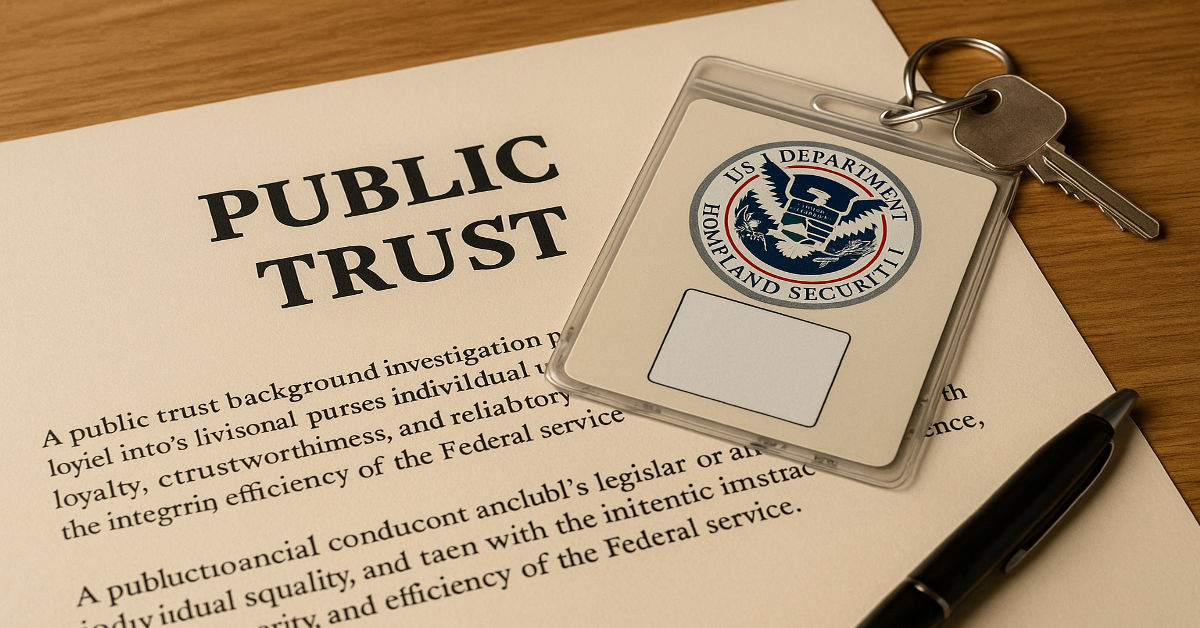If you’re applying for a federal or government-contracted job, you may encounter the term public trust clearance. While it’s not the same as a security clearance, it holds significant weight for roles that involve sensitive yet unclassified information. This article offers a detailed look into what public trust clearance means, why it matters, and what you can expect during the process.
What Is Public Trust Clearance?
Public trust clearance is a background investigation required for positions of public trust—roles that involve access to systems or data that, if misused, could cause harm to the public or government operations. It does not grant access to classified national security information, but it is essential for positions that require a high degree of integrity, reliability, and ethical standards.
Public Trust vs. Security Clearance
The most common confusion arises when people compare public trust to security clearance. Here’s a breakdown:
| Feature | Public Trust Clearance | Security Clearance |
| Access Level | Unclassified but sensitive | Confidential, Secret, or Top Secret |
| Focus | Trustworthiness and reliability | National security concerns |
| Investigation Depth | Moderate to high background checks | Varies based on clearance level |
| Issued For | Civil service and contractor jobs | Defense or intelligence positions |
While public trust is less intensive than security clearance, the vetting process still digs deep into your background.
Who Needs Public Trust Clearance?
Public trust clearance is required for individuals working in roles where integrity and accountability are crucial—even if they don’t handle classified information.
Typical jobs that require public trust clearance include:
- IT specialists working on government systems
- Healthcare professionals in federal agencies
- Financial auditors or analysts
- Contracted workers supporting federal operations
- Human resources personnel in federal roles
Types and Tiers of Public Trust Positions
There are two main levels of public trust clearance, which vary based on the sensitivity and potential impact of the position.
Low-Risk (Non-Sensitive)
- Entry-level positions with minimal access to sensitive systems
- Often involves a basic background check
Moderate- or High-Risk (Public Trust)
- Access to sensitive personal information, financial systems, or IT infrastructure
- Requires a more detailed investigation and adjudication
The Public Trust Clearance Process
The process can take several weeks to a few months, depending on the level of clearance and the thoroughness of the background check.
Steps include:
- Job offer contingent on clearance
- Completion of background investigation forms (SF-85 or SF-85P)
- Fingerprinting and identity verification
- In-depth background check by OPM or DHS
- Adjudication (final review)
- Clearance granted or denied
Forms and Documentation Required
The form you complete depends on the sensitivity of the position:
| Form Name | Use Case |
| SF-85 | For low-risk non-sensitive positions |
| SF-85P | For public trust (moderate/high-risk) |
You may also need:
- Fingerprint cards
- Authorization forms for credit or medical checks
- Employment verification
- Foreign contact disclosures
Background Investigation Details
A public trust clearance investigation includes:
- Criminal history
- Credit reports and financial standing
- Drug use or addiction
- Employment history
- Education verification
- References and personal conduct
- Residency and foreign contacts
The level of scrutiny increases with the level of access the job entails.
Factors That Can Affect Approval
Several issues can delay or prevent you from receiving public trust clearance. Common red flags include:
- History of financial irresponsibility (e.g., unpaid debts, bankruptcy)
- Criminal convictions
- Substance abuse
- Falsifying records
- Unreported foreign contacts or travel
- Termination from previous employment for misconduct
Mitigation, such as demonstrating rehabilitation or honest disclosure, often plays a key role in adjudication.
Duration and Renewal of Public Trust Clearance
Once granted, public trust clearance typically remains active as long as you are employed in a position requiring it. However, periodic reinvestigations may occur every five to ten years.
Reinvestigation involves updating your forms and background checks. It ensures that you continue to meet the standards of trustworthiness.
Maintaining Clearance Status
Maintaining clearance means:
- Reporting any major life changes (e.g., arrests, financial issues)
- Avoiding behavior that could be seen as unethical or illegal
- Staying compliant with agency rules
Loss of clearance may result in reassignment or termination.
Public Trust Clearance and Government Jobs
Many civil service and federal contractor jobs require some level of clearance. Agencies like:
- Department of Homeland Security (DHS)
- Social Security Administration (SSA)
- Department of Health and Human Services (HHS)
- Veterans Affairs (VA)
…all require varying levels of trustworthiness due to the sensitive nature of the information they handle.
Common Misconceptions
Myth 1: Public trust is the same as a security clearance.
Truth: Public trust does not grant access to classified materials.
Myth 2: Everyone applying for a federal job needs clearance.
Truth: Only positions with specific risks require public trust clearanc’e.
Myth 3: A poor credit score will always result in denial.
Truth: Financial issues can be mitigated through explanation and positive recent history.
Tips for a Smooth Clearance Process
- Be honest and complete on all forms.
- Disclose all relevant information—even if you’re unsure it matters.
- Keep your documentation ready, including previous employment or legal records.
- Inform your references that they may be contacted.
- Avoid unnecessary delays by submitting forms on time.
Legal and Privacy Considerations
All information submitted is handled under the Privacy Act. You have the right to:
- Review your background file
- Correct inaccurate data
- Appeal decisions if clearance is denied
Government agencies must follow strict guidelines when evaluating your background.
How to Check Status and Appeal Decisions
You can usually check the status through the hiring agency or HR contact. In some cases, platforms like e-QIP or OPM’s system provide updates.
If denied:
- You’ll receive a Statement of Reasons (SOR)
- You can submit a written rebuttal or request a hearing
- Appeals are reviewed by an adjudicator or panel
Case Studies and Real-World Examples
Case 1: IT Specialist Denied Clearance
An applicant for a government IT role was denied clearance due to multiple unpaid student loans. After enrolling in a repayment program and showing consistent payments, they reapplied and were approved.
Case 2: Clearance Granted Despite Minor Criminal Record
An administrative assistant had a misdemeanor on their record from over a decade ago. Due to the age of the offense and clean record since, clearance was granted.
Conclusion
Public trust clearance is an essential credential for thousands of professionals working in federal roles and supporting contracts. While it doesn’t involve access to classified data, it signifies a high level of trust, responsibility, and ethical standards.
If you’re pursuing a job that requires this clearance, understanding the process—and being prepared—can make the journey smoother and more successful.
Frequently Asked Questions
Is public trust clearanc’e a one-time thing?
No, it may require renewal or reinvestigation depending on your role.
Can I apply for a job before I get clearance?
Yes. Most jobs make the offer contingent upon successfully obtaining clearance.
How long does the process take?
Typically 1 to 6 months depending on the clearance level and complexity of your background.
Does public trust clearanc’e expire?
Not exactly, but it can lapse if you leave the job or if reinvestigation is overdue.
Can I appeal a denial?
Yes. The process includes formal steps for appeal and review.











